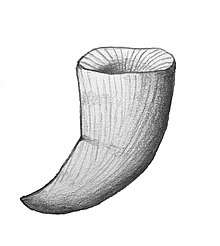Phaulactis cyathophylloides
Phaulactis cyathophylloides is an extinct species of rugose coral known from the silurian layers of Gotland, and Estonia.[1] It is the type species of the genus Phaulactis and was described by Ryder in 1926. It can grow to relatively large sizes.[2]
| Phaulactis cyathophylloides | |
|---|---|
 | |
| An illustration of Phaulactis cyathophylloides. | |
| Scientific classification | |
| Kingdom: | |
| Phylum: | |
| Class: | |
| Order: | |
| Family: | †Lykophyllidae |
| Genus: | |
| Species: | †P cyathophylloides |
| Binomial name | |
| Phaulactis cyathophylloides Ryder, 1926 | |
Description
The species can have two different shapes, either turbinate or cylindrical. It can grow to 60 mm in length and 20 mm in diameter. The calyx is very deep and the septal ridges are well marked. As all other Phaulactis species, it has large amount of septa.[3]
gollark: https://external-content.duckduckgo.com/iu/?u=https%3A%2F%2Fi1.wp.com%2Fpuzzlewocky.com%2Fwp-content%2Fuploads%2F2015%2F04%2Fnewcombsparadox.jpg%3Fresize%3D639%252C229%26ssl%3D1&f=1&nofb=1
gollark: Here's a "helpful" illustration.
gollark: Consider the scenario: there are two boxes before you. One of the boxes (let us call it "A") is transparent and contains £10000, which you can see. The other box ("B") is opaque. It contains £1000000 if and only if the entity running this weird scenario predicted (beforehand) that you'll take box B and not box A. Historically, it has been right the vast majority of the time about this. Your options are to take both boxes, or just to take B. What do?!
gollark: Anyway, while I exist, Newcomb's paradox is a fun if not particularly related problem in decision theory.
gollark: When have I *ever* said false things?
References
- "Phaulactis cyathophylloides". Fossiilid.info. Retrieved 2019-06-09.
- "Phaulactis". Fossiilid.info. Retrieved 2019-06-09.
- "Phaulactis". Fossiilid.info. Retrieved 2019-06-09.
This article is issued from Wikipedia. The text is licensed under Creative Commons - Attribution - Sharealike. Additional terms may apply for the media files.